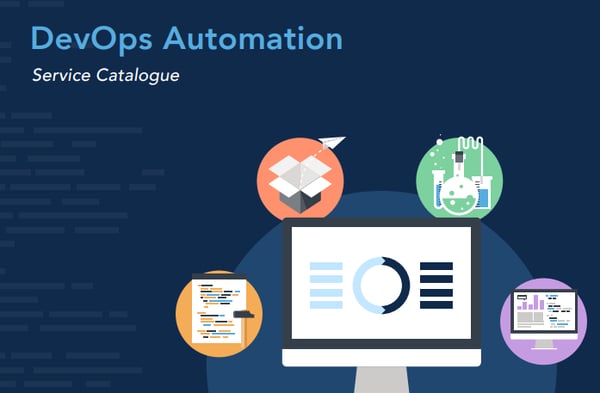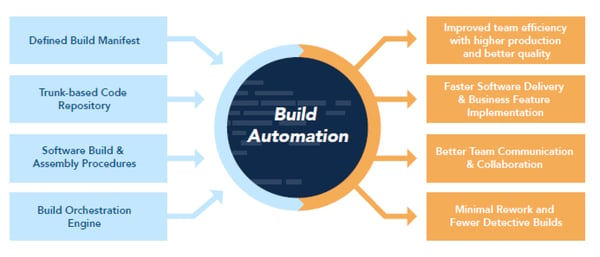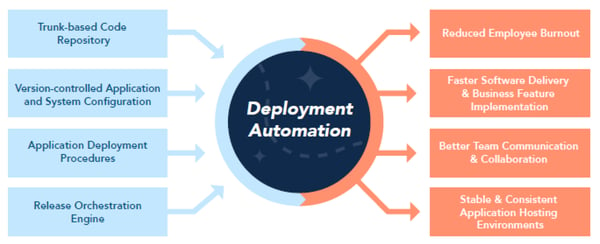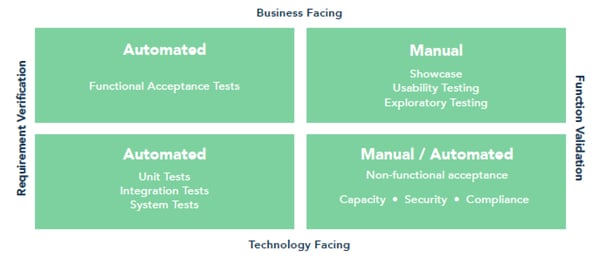Just as the Industrial Revolution introduced the manufacturing industry to rolling assembly lines and automated processes, DevOps processes are ingrained with automation techniques that provide rapid feedback, repeatable processes, and consistent creation of business application systems. With the convergence of multiple systems and IT professionals all focusing on the delivery of these applications, these processes quickly become complex and can seem daunting to implement for the first time.
Vizuri experts have grouped DevOps automation processes into four areas of focus for implementing automation that can each help your organization gain efficiencies and improve your overall IT processes: Build, Deployment, Test, and Infrastructure.
Download our DevOps Automation Service Catalogue for a deeper dive into our segmented approach
With each of these areas, our experts will guide your organization in the development of optimized IT processes that adopt core enabling disciplines, monitor key performance indicators, and avoid potential red flag areas. The goals of these four areas are:
- Define and execute a consistent and repeatable process.
- Amplify feedback and improve team communication.
- Improve overall release deployment quality.
- Accelerate the implementation of desired business features/functionalities and the delivery of application features to production.
1. Build Automation
Build Automation is the process of scripting and automating the retrieval of software code from a repository, compiling it into a binary artifact, executing automated functional tests, and publishing it into a shared and centralized repository.
Key roles include:
- Developer: Responsible for taking business requirement and implementing in software code
- Build Engineer: Responsible for defining the release pipelines and maintaining the build infrastructure
- Requirements Analyst: Responsible for defining the user story to include the definition of acceptance criteria
2. Deployment Automation
Deployment Automation is the process of provisioning the application artifacts and configurations to the operating environments across the system development lifecycle. It entails a combination of application deployment automation, environment modeling, and workflow orchestration to achieve rapid delivery of application features in a reliable and orderly manner.
Key roles include:
- System Administrator: Responsible for preparing and modeling the target environments and deploying the application into each of them
- Build Engineer: Responsible for defining the release requirements and supporting the application deployment
- Developer: Responsible for taking business requirement and implementing in software code
3. Test Automation
Test Automation is a practice where application tests are run automatically and continuously throughout the development process. Test-driven development and the use of unit tests are used to create and maintain acceptance tests that are reproducible and executed with each build. A typical project will implement a strategy similar to that of the Agile Testing Quadrants model shown above.
Key roles include:
- System Administrator: Responsible for preparing and modeling the test environments and deploying the application into each of them
- Test Engineer: Responsible for defining the release pipelines and maintaining the build infrastructure
- Developer: Responsible for the application development and defect resolution
- Release Manager: Responsible for defining and communicating the application release plans and reporting on the progress of the deployments
4. Infrastructure Automation
Infrastructure Automation is the process of creating and tearing down server and application infrastructure to support the development, testing, and production environments.
Key roles include:
- System Administrator: Responsible for preparing and modeling the target environments and deploying the application into each of them
- Build Engineer: Responsible for defining the release requirements and supporting the application deployment
- Release Manager: Responsible for defining and communicating the application release plans and reporting on the progress of the deployments
Vizuri works with complex applications on behalf of private-and public-sector clients, tailoring support to their needs. We provide measurable outcomes by offering substantial experience in software system development lifecycles, backed by leading qualifications in cloud, container, and CI/CD technologies.
Vizuri's assessment-derived solutions are tailored to each client's needs. We work with you to define the right offerings required to build a solid foundation based on DevOps principles. Check out our work with travel data management company ATPCO and learn how we guided the development of their DevOps road map to incrementally adopt new technologies.
Our experts provide deep expertise with the tools across the DevOps ecosystem that are essential to promoting a collaborative project environment. As such, we accelerate initiatives by integrating DevOps tools and processes from the start, and we then sustain them by nurturing a continuous learning environment for your community of DevOps practitioners.
Get the full version of our DevOps Automation Service Catalogue for a detailed look into our approach and reach out any time for more info.









